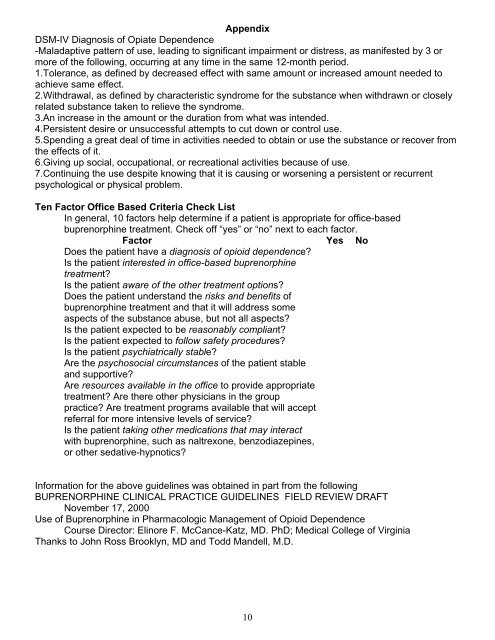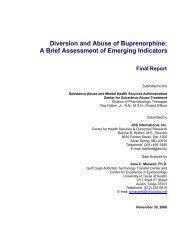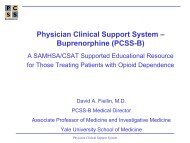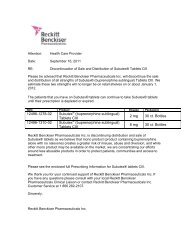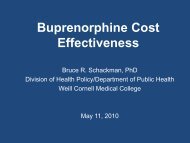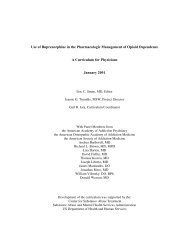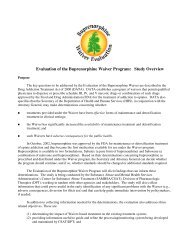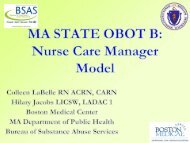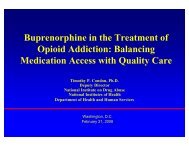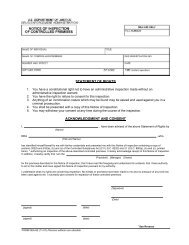Diversion and Abuse of Buprenorphine: A Brief Assessment of ...
Diversion and Abuse of Buprenorphine: A Brief Assessment of ...
Diversion and Abuse of Buprenorphine: A Brief Assessment of ...
Create successful ePaper yourself
Turn your PDF publications into a flip-book with our unique Google optimized e-Paper software.
Appendix<br />
DSM-IV Diagnosis <strong>of</strong> Opiate Dependence<br />
-Maladaptive pattern <strong>of</strong> use, leading to significant impairment or distress, as manifested by 3 or<br />
more <strong>of</strong> the following, occurring at any time in the same 12-month period.<br />
1.Tolerance, as defined by decreased effect with same amount or increased amount needed to<br />
achieve same effect.<br />
2.Withdrawal, as defined by characteristic syndrome for the substance when withdrawn or closely<br />
related substance taken to relieve the syndrome.<br />
3.An increase in the amount or the duration from what was intended.<br />
4.Persistent desire or unsuccessful attempts to cut down or control use.<br />
5.Spending a great deal <strong>of</strong> time in activities needed to obtain or use the substance or recover from<br />
the effects <strong>of</strong> it.<br />
6.Giving up social, occupational, or recreational activities because <strong>of</strong> use.<br />
7.Continuing the use despite knowing that it is causing or worsening a persistent or recurrent<br />
psychological or physical problem.<br />
Ten Factor Office Based Criteria Check List<br />
In general, 10 factors help determine if a patient is appropriate for <strong>of</strong>fice-based<br />
buprenorphine treatment. Check <strong>of</strong>f “yes” or “no” next to each factor.<br />
Factor Yes No<br />
Does the patient have a diagnosis <strong>of</strong> opioid dependence?<br />
Is the patient interested in <strong>of</strong>fice-based buprenorphine<br />
treatment?<br />
Is the patient aware <strong>of</strong> the other treatment options?<br />
Does the patient underst<strong>and</strong> the risks <strong>and</strong> benefits <strong>of</strong><br />
buprenorphine treatment <strong>and</strong> that it will address some<br />
aspects <strong>of</strong> the substance abuse, but not all aspects?<br />
Is the patient expected to be reasonably compliant?<br />
Is the patient expected to follow safety procedures?<br />
Is the patient psychiatrically stable?<br />
Are the psychosocial circumstances <strong>of</strong> the patient stable<br />
<strong>and</strong> supportive?<br />
Are resources available in the <strong>of</strong>fice to provide appropriate<br />
treatment? Are there other physicians in the group<br />
practice? Are treatment programs available that will accept<br />
referral for more intensive levels <strong>of</strong> service?<br />
Is the patient taking other medications that may interact<br />
with buprenorphine, such as naltrexone, benzodiazepines,<br />
or other sedative-hypnotics?<br />
Information for the above guidelines was obtained in part from the following<br />
BUPRENORPHINE CLINICAL PRACTICE GUIDELINES FIELD REVIEW DRAFT<br />
November 17, 2000<br />
Use <strong>of</strong> <strong>Buprenorphine</strong> in Pharmacologic Management <strong>of</strong> Opioid Dependence<br />
Course Director: Elinore F. McCance-Katz, MD. PhD; Medical College <strong>of</strong> Virginia<br />
Thanks to John Ross Brooklyn, MD <strong>and</strong> Todd M<strong>and</strong>ell, M.D.<br />
10


